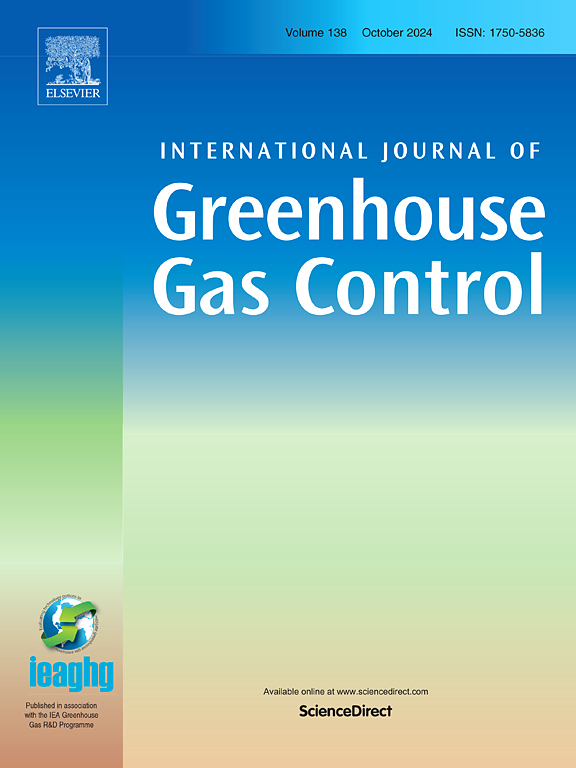The prospects of massively scalable nuclear-powered direct air capture as a climate solution
IF 5.2
3区 工程技术
Q2 ENERGY & FUELS
International Journal of Greenhouse Gas Control
Pub Date : 2025-05-02
DOI:10.1016/j.ijggc.2025.104390
引用次数: 0
Abstract
Direct air capture (DAC) has recently emerged as a promising and scalable solution for removing accumulated CO2 in the atmosphere to mitigate global warming. Because DAC needs to capture CO2 from highly diluted levels in the air, it has considerably higher energy demands than conventional CO2 capture from concentrated industrial sources, making cheap input energy essential. The present study proposes that DAC facilities be powered by dedicated large-scale nuclear power plants designed to deliver the optimal heat/electricity ratio to a DAC unit serving as the condenser in the Rankine power cycle. Such plants are unbound by proximity requirements to CO2 point sources or electricity demand centres and can be built where nuclear reactors are cheapest to construct, strongly improving the business case. A bottom-up techno-economic assessment and uncertainty quantification study for the year 2050 showed median and 90 % confidence intervals of the levelized cost of removed CO2 to be 101.6 (71.3–153.9) $/ton when conventional nuclear reactor technology is used. An advanced configuration employing emerging high-temperature nuclear reactor technology to generate excess electricity for co-production of green methanol was slightly more expensive with a larger uncertainty range: 108.0 (68.8–176.1) $/ton. Despite the uncertainty in the assessment, the calculated CO2 removal costs are attractive compared to projected CO2 prices in climate change mitigation scenarios targeting substantial emissions reductions by mid-century. However, several non-economic challenges were identified and further work on these topics is recommended to clarify the long-term potential of nuclear-DAC technology as a leading climate change solution.
大规模可扩展的核动力直接空气捕获作为气候解决方案的前景
直接空气捕获(DAC)最近成为一种有前途的、可扩展的解决方案,用于去除大气中积累的二氧化碳,以缓解全球变暖。由于DAC需要从空气中高度稀释的水平捕获二氧化碳,因此它的能源需求比从集中的工业来源捕获传统的二氧化碳要高得多,因此廉价的输入能源至关重要。本研究建议DAC设施由专门的大型核电站提供动力,旨在为DAC单元提供最佳的热电比,该单元在朗肯电力循环中充当冷凝器。这样的电厂不受靠近二氧化碳点源或电力需求中心的限制,而且可以建在核反应堆造价最便宜的地方,从而大大提高了商业效益。一项针对2050年的自下而上的技术经济评估和不确定性量化研究表明,当使用常规核反应堆技术时,去除二氧化碳的平准化成本的中位数和90%置信区间为101.6(71.3-153.9)美元/吨。采用新兴高温核反应堆技术产生多余电力用于联合生产绿色甲醇的先进配置略贵,不确定性范围更大:108.0(68.8-176.1)美元/吨。尽管评估存在不确定性,但与以到本世纪中叶大幅减少排放为目标的减缓气候变化情景下的预估二氧化碳价格相比,计算出的二氧化碳清除成本具有吸引力。然而,确定了一些非经济挑战,并建议就这些主题开展进一步的工作,以澄清核dac技术作为主要气候变化解决方案的长期潜力。
本文章由计算机程序翻译,如有差异,请以英文原文为准。
求助全文
约1分钟内获得全文
求助全文
来源期刊
CiteScore
9.20
自引率
10.30%
发文量
199
审稿时长
4.8 months
期刊介绍:
The International Journal of Greenhouse Gas Control is a peer reviewed journal focusing on scientific and engineering developments in greenhouse gas control through capture and storage at large stationary emitters in the power sector and in other major resource, manufacturing and production industries. The Journal covers all greenhouse gas emissions within the power and industrial sectors, and comprises both technical and non-technical related literature in one volume. Original research, review and comments papers are included.

 求助内容:
求助内容: 应助结果提醒方式:
应助结果提醒方式:


